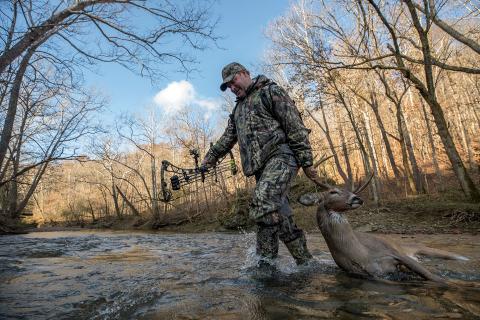with Bill Gibson of Mossy Oak GameKeeper Kennels
provided by John Phillips
Bill Gibson, the director of Mossy Oak GameKeeper Kennels, primarily trains British Labrador retrievers, and the kennels’ specialty is dogs from the Republic of Ireland and the United Kingdom. According to Gibson, “These Labs aren’t hyper, have superior noses to U.S.-bred Labradors and have exceptional game-finding abilities.” A member of the U.S. Gun Dog Team in 2004, Gibson competed against dogs from England, Scotland, Wales, the Republic of Ireland and Northern Ireland.
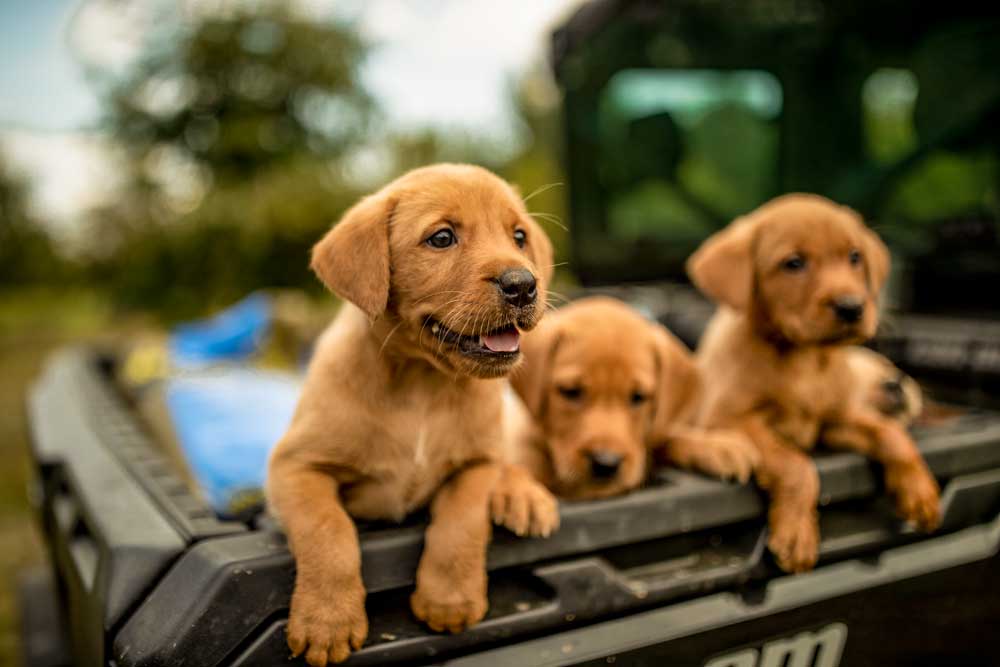
Selecting Your Retriever Puppy
I usually suggest you turn your back to the litter of pups, back up, reach down and grab a pup, to choose a Labrador puppy to train as a gun dog. There’s really no way to tell how good a six- or seven-week-old pup will be when you pick one out, but there are a few puppy characteristics I want to see.
I can tell right away the puppies that have focus and aren’t just bouncing off the walls, when I go into our puppy house, as the pups sit and look at me. That’s a pretty good indicator of how that puppy will react in future training. I look to see if the pup is focused on me, paying attention to me and trying to figure out what I want him to do, and how he’ll do it. That puppy’s trying to decide what I want by my being in his kennel.
I look for tail position. I don’t want a pup to have his tail up so high he looks like he may hit his head with that tail. He’s indicating that he’s trying to be the top dog in the litter, and that pup often will become very dominant. I don’t want a very dominant puppy, because he’ll be hardheaded about taking instructions and probably difficult to train.
A dog with its tail sticking straight out vertically or just slightly vertical is more than likely in the middle spectrum of attitude and will be trained easily. A pup with its tail tucked between its legs may be submissive and difficult to train, because he’s a little more timid than the other pups.
Sometimes when you go to a breeder or a trainer, he may tell you, “I can look at these puppies and pick a pup to match your personality.” However, I’ve found that statement to be a bunch of baloney. I’ve never been able to match a pup to a person’s personality. Truthfully, I usually don’t know the person very well who’s buying the pup. I don’t know a seven-week-old pup well enough to match it to its future owner. Also, from seven-weeks old to six-months old is when a puppy develops his personality. Another question I’m often asked is, “Can you tell if a puppy will be gun-shy or not?” and the answer is, “No.” A puppy isn’t born gun-shy - that’s a trait that’s learned or developed.
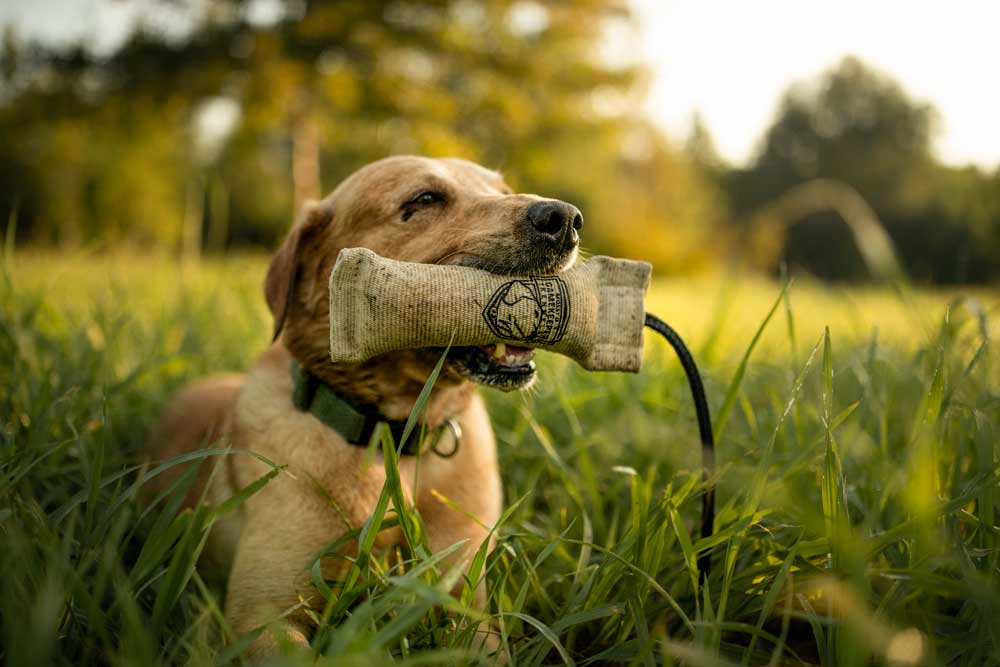
What Causes Dogs to Become Gun-Shy?
The primary reason a puppy or a dog becomes gun-shy is improper training. Some things that happen to puppies can cause them to be gun-shy include someone:
* Beating loudly on a pan when a puppy comes to its bowl to eat. Some people think that beating on a pan while the pup’s trying to eat can help the dog become accustomed to being around loud noises, like a gun going off. I explain that if I’m sitting down to eat a steak, and someone walks behind me or above me and starts beating on a wash tub as hard as they can, that person is about to have a problem with me. That puppy won’t enjoy his meal with a pan being banged in his ears.
* Shooting a starter pistol like the ones used for track meets around a puppy
* Taking a pup to a shooting range where there’s plenty of shooting and loud racket happening
I can assure you that any person using any of those training tactics will have a gun-shy dog. I train a puppy to not be gun-shy like this:
I have a .22 pistol with a dummy launcher on the front of it. When I fire the pistol, the blast from the pistol shoots the dummy up in the air. I’ll walk the puppy out to 100 yards and get him to sit there; then I’ll walk another 100 yards in front of him. I’ll fire a round, the dummy will go up in the air, the puppy will see the dummy go up in the air and then run to the spot where it’s seen the dummy fall, and pick up the dummy and bring it to me.
By using this process, I’ve taught the puppy several things:
* He will be rewarded. He’s learned that any time he picks up a training dummy and brings it to me, I’ll pet and praise him and make him feel good about himself. That’s what a retrieving dog wants - to get his reward every time he goes out, makes a retrieve and returns to his owner or handler by being praised and petted.
* The puppy learns with this training method that when he hears gunfire, to look up in the sky and see if he can see anything falling. This part of the drill teaches the puppy how to look for a bird and watch it fall. (Initially, he’s actually not looking at a bird but rather a dummy.)
* The puppy that looks up and sees something flying after it hears a gun go off also is learning to sit and stay until the pup’s given the command to retrieve. The puppy can’t make the retrieve until I tell it to do so.
So, with this little simple drill, the dog has learned that when it hears gunfire and looks up in the air, the puppy will see something flying or falling. It has also learned that when the dummy hits the ground out in front of it, if the dog retrieves that dummy, the dog will be praised and petted. That puppy will learn to be steady and sit calmly, until I give it the command to release it to pick up the dummy and bring it to me. Everything about training a retriever is built on the foundation of obedience training, which is the first course in training a retriever.
After the dog and I have had a good time with the pistol and shooting the dummy, I’ll hold a dummy in my hand, let the dog walk out into the field with me, pitch the dummy out and allow it to hit the ground. The dog will see where the dummy lands and want to retrieve it, but I won’t let the pup move until I give it the command. This training teaches the young dog that everything he sees up in the air when a shot goes off, and everything that falls to the ground is not his to go and retrieve.
Sometimes, after I pitch the dummy out, I’ll tell the dog to heel, and I’ll walk to the dummy and pick it up. This helps the dog to learn that when he hears a shot and something falls, he’s not to retrieve it, unless I tell him to retrieve it. I do this because there may be times when you’re hunting with several other hunters who have their dogs with them, and perhaps they want to send their dogs to retrieve the ducks, doves, geese or whatever birds they’ve shot.
After the dog learns that technique, we’ll use two dogs at one time. When I throw a dummy out, I’ll call the dog’s name that I want to retrieve the dummy, and that dog will go pick up the dummy, bring it back and put it in my hand, while the other dog is in the sit/stay position. This way, he learns when he’s supposed to make a retrieve, and when he’s not to make a retrieve. Once again, every step of training a retriever is built on the obedience training that dog has learned.
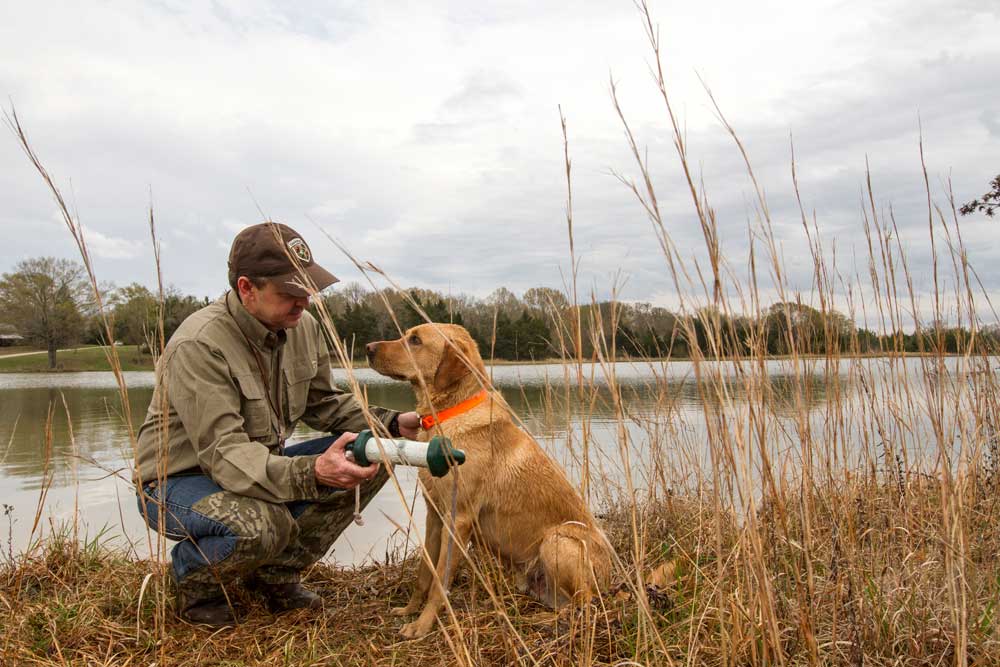
How to Solve Problems with Gun Dogs
“I’ve got a problem with my dog, can you fix it?” is something we often hear at the Mossy Oak GameKeeper Kennels. Occasionally, we’ll have an owner bring us a dog that the owner has trained, and he’ll say, “I’ve got a problem with my dog. Can you fix the dog, so I won’t have that problem anymore?” Occasionally we can, but we don’t look for difficult dogs to train. Here’s some of what we’ve learned when working with owners with gun-shy dogs.
* A Gun-Shy Dog Caused by Loud Noises:
I had an owner call me and say, “I took my dog to another trainer, and he said my dog was gun-shy. Can you help my dog not be gun-shy?” Next, I asked a series of questions to learn what had caused the dog to be gun-shy. She explained, “I haven’t had anyone shooting around my dog, and the only thing I know that he’s been exposed to is roofers. When I walked him around the block, one of my neighbors was having a new roof put on - using those air-gun type staplers to staple the shingles to the roof. When he saw and heard that racket - bang, bang, bang, bang, bang! - the dog stopped and wouldn’t go any further. Anytime I’d try to walk him around the block after that, the dog would stop in the same place and wouldn’t go any further.”
I told the owner her dog had been made to be gun-shy by having the wrong introduction to noises. I recommended she bring her dog over to our kennels, and we’d try to straighten him out. We had the gun-shy dog sit 50 yards from the dummy launcher and launched a dummy. The dog wouldn’t go anywhere near the dummy launcher; he was too scared. So, I kept him here at the house.
Next, I had him sit beside me, got the pistol we used for a dummy launcher - without a shell in the pistol - and cocked the hammer, pulled the trigger and dry-fired the dummy launcher. When clicking the pistol didn’t bother him, because he’d become accustomed to it, I’d dry fire the pistol and throw the dummy out in front of me and the dog. I’d keep throwing the dummy and clicking the pistol, until the dog quit reacting to dry-firing the pistol. Nothing about the dog’s body language indicated he was afraid of that noise.
After the dog wasn’t afraid of that sound, we took him outside, had him sit and took the dummy launcher about 200 yards from him. Then while I stayed with the dog, my assistant fired the pistol that launched the dummy toward us. The dog would go pick up the dummy and bring it to me. Over a series of days, we’d move closer and closer to the dummy launcher and repeat this drill, until the dog was sitting right next to the launcher when we fired it. In fact, later when he’d come in the house and see the launcher with the dummy in it, he’d start salivating because he’d want to do a retrieve and get his reward of praise and petting.
More than a month was required for us to go through this process of getting the dog to where he was steady when a gun was fired near him, and we could send him out to retrieve the dummy. That whole gun-shy episode could have been avoided if the lady hadn’t walked the dog close to where the roofers were roofing. However, in her defense, she didn’t know that would cause the dog to be gun-shy.
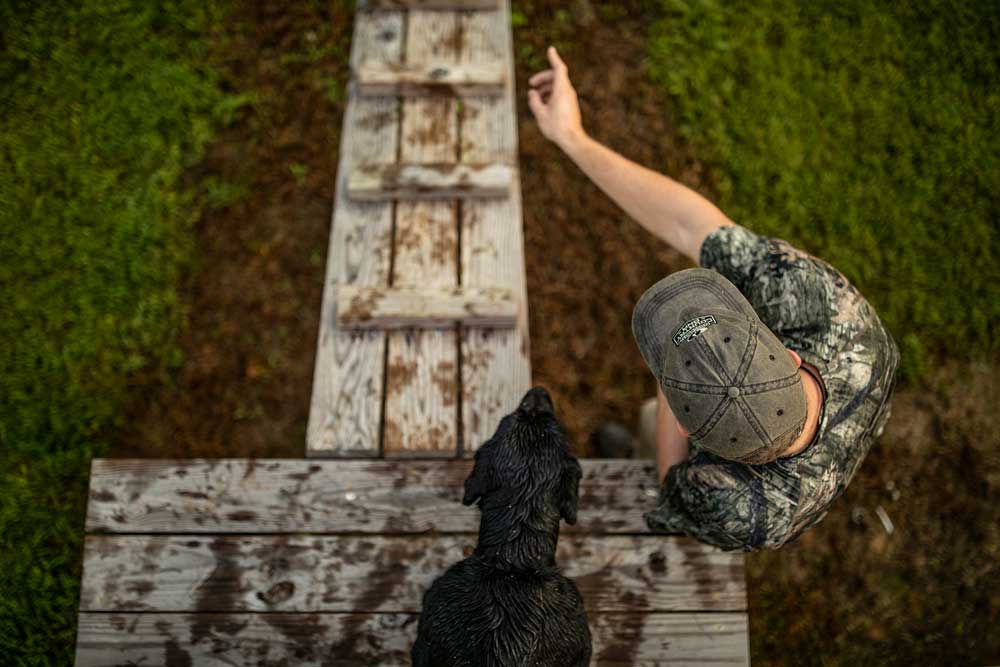
* A Gun-Shy Dog Created from Too Many Duck Hunters Shooting:
Another problem we’re often asked to solve is when an owner takes his dog to a duck blind with other duck hunters there with retrievers, and he wants to show his dog off, so the other hunters can see how obedient and well-trained his dog is. If a flight of ducks comes in, six or eight people are in that blind, and all of the hunters empty their guns shooting at the ducks, they’ll probably scare the dickens out of that dog. I tell all the people I train for to not do that.
The best way to introduce a dog to working with a hunter and to the loud sounds of shooting is not to take your dog with numbers of other hunters - especially the first time you take your dog to a duck blind. Instead, take one of your friends to your duck blind, and don’t take a gun for yourself. Work your dog, and let your friend do the shooting. That way, your dog knows that someone he loves (his handler) is sitting right beside him when the gun goes off, and that nothing bad will happen to him. If he sees a duck fall, send him to retrieve it, and then praise him and pet him. When he knows he has his reward, and his handler is right there with him, he has every reason to believe that the next time he goes to a duck blind he’ll be able to sit still, retrieve the duck like he should and then get his reward. I think training a retriever mainly requires using common sense.
* A Young Dog with Too Many Opportunities to Retrieve:
We only allow our young dogs starting out to make one to three retrieves in a day. If you begin throwing a dummy, sending the young dog to get it, taking the dummy out of its mouth when the dog brings it back to you and keep throwing that dummy, your dog will tire out. In fact, when the dog gets tired, he’ll drop the dummy before he gets to you. He’s learned that if he brings the dummy to you, you’ll throw it again, and he’ll have to run to retrieve it again. He’s too tired to do it. You’re teaching that pup to drop the duck or dummy, instead of bringing it to you. Because you’ve just taught your dog a conditioned habit, if the dog’s been overworked on retrieving, you may not ever be able to teach him not to drop the dummy or the duck instead of bringing the object to you. If the pup’s only seven or eight weeks old and makes one or two good retrieves in a day, that’s enough for him to start to learn to retrieve.
A better way to start teaching a pup to retrieve is: go to a hallway in your house, shut all the doors leading into any rooms along the hallway, and then sit the puppy between your legs. If you’re right-handed, hold the pup with your left hand, take a rolled up sock and throw it down the hall. Then, release the pup. He should run down the hall and pick up the rolled-up sock. The dog doesn’t have anywhere else to go except right back to you since all the hall doors are closed. When you take the sock from the pup, make the pup sit between your legs, put your left hand on it, throw the sock, and let the pup retrieve it. One or two of those exercises per day with a young dog will get that young pup started on the right road to being a retriever.
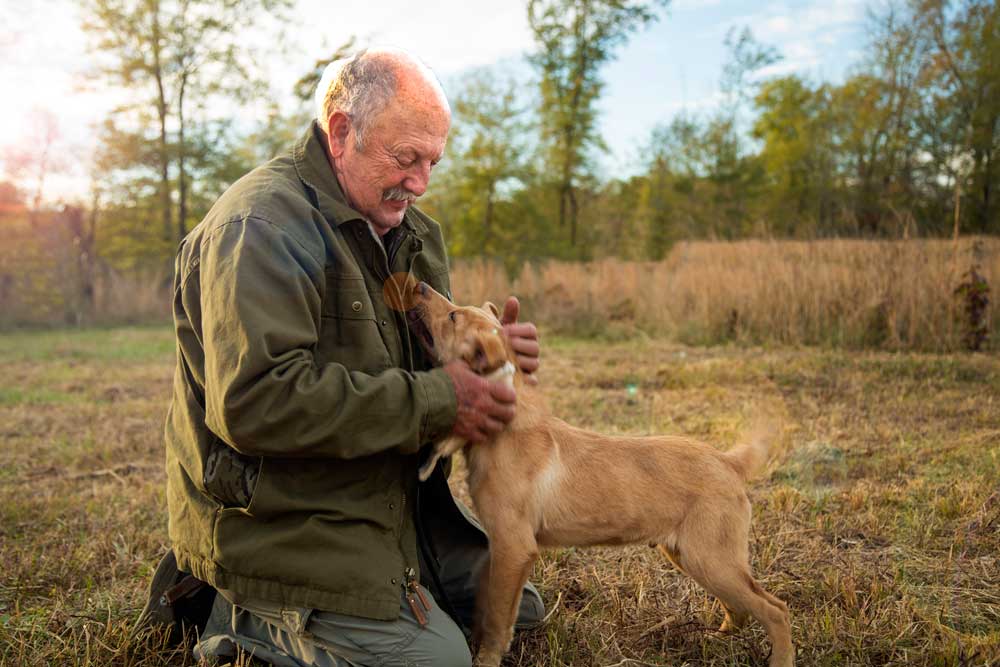
How to Understand Your Retriever’s Genetic Wiring
Although retrievers have been bred to retrieve, not all retrievers will retrieve. Some young dogs aren’t genetically wired to retrieve, and as soon as you and your trainer realize that your pup just doesn’t want to retrieve, the best thing you can do is get another dog to use to retrieve.
I’m often asked, “How early in a pup’s training can you make a decision that that pup isn’t genetically wired to be a retriever?” When we have a litter of young pups, we’ll bring them in one at a time to the office and test this by throwing out a dummy. If the puppy’s wired to be a retriever, within four or five times after we throw that dummy out, if that pup picks up the dummy and brings it back to us, we assume that he has the genetic retrieving power to be a good retriever. By the time a pup is 6-1/2 weeks old, that pup should be able to run out 20 or 30 yards, pick up the dummy and bring it back to me. If a puppy doesn’t run out to get the dummy, doesn’t sniff at the dummy and doesn’t want to play with the dummy, then, more than likely, that pup won’t make a very good retriever. That pup may not have been bred by retrievers that were hunting dogs, meaning that the genetics aren’t in that pup for it to naturally want to pick up something and bring it back to his owner or handler.
How Much Time is Required to Train a Retriever Pup?
Many owners ask me this question, and my answer always is, “How can I know that?”
Dogs are like people; they’re all different. Some dogs learn quickly, some slowly, and some dogs don’t learn at all. They’re like children. Some children are super smart and learn quickly, while other children are smart too but perhaps they don’t apply themselves. It’s the same with dogs – some dogs just take longer to train.
At the Mossy Oak GameKeeper Kennels, we offer a training program that’s outlined that we can give to people who purchase our dogs. If they’ll follow the pre-training program at home with their dogs from 7-8 weeks old until he’s 6 months old, then there’s a good chance that dog will learn quickly. The pup will come into our training program already knowing many of the things we’ll ask him to do. I tell each owner what I expect each pup to be able to do when he or she brings the pup back to me when it’s 6 months old. But one of the problems we have sometimes is that the owner won’t spend the time required to train that dog during that 7-week-old to 6-month-old pre-kennel time.
Do Obedience Training First
I’m often asked when a hunter brings his dog to the Mossy Oak GameKeeper Kennels, and his dog already will come when he calls the pup and go out and pick up a dummy or a sock to bring it back, why we start all retriever training with obedience training. Obedience training is the foundation for all the other skills that the dog needs to learn. We want the dogs we train to be:
* steady to shot – not break and run to retrieve until they’re given the command to retrieve
* steady to fall – not break and start running to the bird as it falls, but wait until its handler gives him the command to retrieve
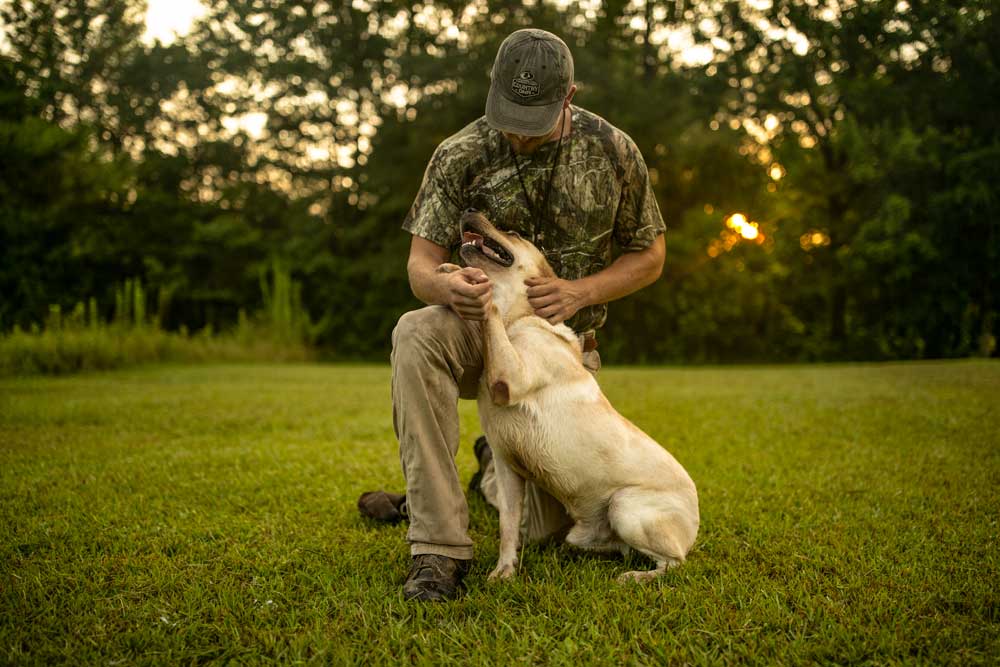
We start obedience training with our kennel pups once they’re 7 weeks old, and we advise future clients to start obedience training the same way we do. We begin with food bowl training. I’ll put food in the pup’s food bowl, and then use my hand to stir up the food to get my human scent on the food the pup will eat. Then I let the pup see what I’ve done, and I’ll next hold the bowl up well over the pup’s head and teach it to sit. I’ll put a little pressure on the pup’s rear end to help teach it what the word, “Sit,” means. Once the pup is sitting, I’ll start lowering the bowl. If the pup gets up, I’ll use my hands on its rear and give it the command, “Sit.” As I bring the food bowl down to the ground, I expect the pup to sit still until I give him the command, “Okay.” Then the pup can come up from the sit position and run to its bowl to eat. Usually a good pup will learn this first step of obedience training within 2-3 days of practice.
In our outside kennels at this writing in October, 2021, we have 10 dogs. I’ll set food bowls with food in them outside the kennels where the dogs can see them. I’ll give each dog the command to “Sit.” I’ll next place a food bowl inside each dog’s kennel. By the time I finish putting all 10 food bowls in all the dogs’ kennels, each dog should be sitting and looking at its food bowl, but not eating. Next, I give each dog the command, “Okay.” Then each dog will get up from the sit position, go to its food bowl and eat. The dogs learn to sit and stay until they’re given the “Okay” command, regardless of the task we want them to perform. This sit command not only teaches the dog to sit when the command is given, but it also is communicating to the dog that we want him to sit and be steady - not be moving and not fidgeting.
* Why the Sit/Stay Command Is So Important: This part of training is so important if you’re in a duck blind with three or four buddies and you want your dog to sit in one place and stay there until you give him the command, “Okay,” which means for him to go ahead and make a retrieve. Each of the commands we teach in basic training has connections to the rest of the commands that the dog will need to learn to be a fully-trained retriever. That’s why basic training is so critical in the very beginning of a retriever’s training program.
* Why to Teach the Dog to Heel: Next we teach the dog to heel. If you’re right-handed, you want your dog on your left side with its head right next to your knee. Then, you can walk anywhere without your dog running off or having to be called back.
I truly enjoy retriever training, because I can watch a dog go from a pup to a well-trained working dog in a relatively short time. If the owner continues to work the dog when he takes the pup home, he’ll have a terrific hunting buddy for the life of the dog.
To learn more about how Mossy Oak GameKeeper Kennels can help you train your dog, go to https://www.mossyoakkennels.com/. Or call Bill Gibson at 662-617-4769 or email him at bgibson@mossyoak.com. He’ll be happy to tell you about the services and training opportunities here at the GameKeeper Kennels.
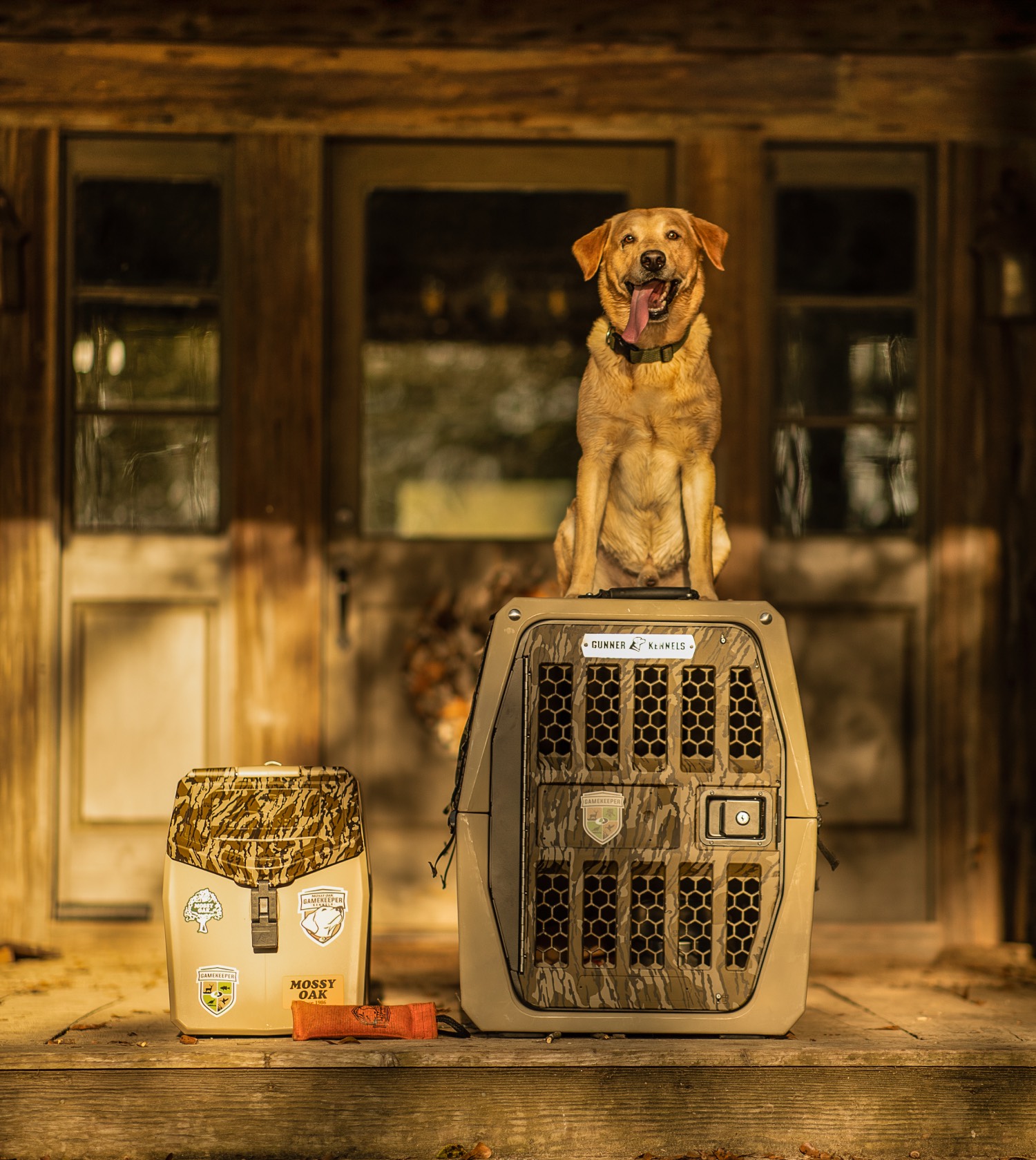
It's important to keep your new hunting buddy safe. You've invested time, money, and your heart into your partner, so keep him or her safe in the car with a Gunner Kennel. We don't leave home without it.
















